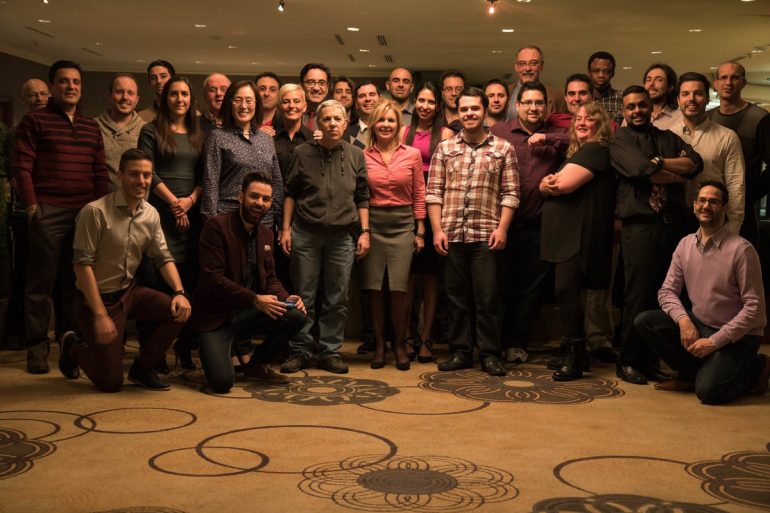As part of a regular series powered by Microsoft, BetaKit interviews prominent Canadian CTOs speaking earnestly on the biggest challenges they face in their role, as well as future technology predictions in their space.
Max Di Paola is on a mission to make the world better through better healthcare. He’s not alone in that mission – many startups are part of Canada’s Healthtech movement – but Di Paola’s vision started with operations and moved to data. While he believes that a team is the most important element of building a company, Di Paola is also adamant that CTOs who want to build world-leading solutions focus on scalable technology architecture on top of team culture.
To Di Paola, both are crucial ingredients, but the order in which they are pursued is key.
Empowering the individual with technology
“I believe the next big thing is educating and empowering the individual so they can move from corrective to predictive healthcare,” Di Paola said as we talked about how AddaTech’s platform helps people.
He explained that an application that fully empowers people to access their own medical records, share health information, and more – all without having to rely on a disconnected healthcare system – is how to revolutionize health.
“The system has to run. The architecture needs to be good. Then you have to be cognizant of where tech is going so you can position yourself.”
Originally developed for clinic admin with a product called Clinicmaster, AddaTech started relatively humbly when you consider Di Paola’s grand ambition.
But, as Di Paola told me, that vision evolved. He began to see the world of medicine in distinct categories. The world is shifting from corrective medicine, where doctors and others treat maladies, to a state of preventative care. We focus on things like exercise and eating well in order to keep our bodies in top shape, building up the strongest natural defences to illness and injury.
Today, Clinicmaster by AddaTech is an all-in-one clinic management tool, including marketing, technology integrations, and data management, but that’s not where the vision ends. What excites Di Paola is moving to predictive care. He sees technologies such as AI helping us become more predictive, where data scientists team up with doctors to help identify actions most likely to cause severe injury or illness before they actually do, empowering intervention before something happens.
Getting a team bought in and letting them be part of the evolution
While predictive healthcare all sounds great in a pitch deck, the reality is that people are the ones who will build the necessary technologies.
“It all comes down to understanding your people,” Di Paola said. “The biggest change [as you and your vision grow] is that fundamentally a company is made up of its employees and you have to accommodate for and account for many people, many lives, and many extensions to those people. To get the best out of your people, you can’t ignore the human side.”
Di Paola went on to note that a relentless focus on people is especially relevant in industries facing constant change. In these times, he said, you always need new skill sets coming onto the team and thus leaders have to develop the skill set to embrace those people.
“It’s about finding balance between life and what technology brings us,” he added, noting that the more people you have, the more variables you have to focus on.
As you add to your team, that means you don’t always get to immediately do things your way. Di Paola said the challenge as a leader then becomes corralling everyone towards your vision.
“I tell my team we are looking to develop the best software, and here’s what we’re going to do to make that happen,” he said. “It’s about sharing the vision. Addressing questions so they feel like they are contributing to something important. This is key especially in small businesses where everyone is impacted [by leadership decisions].”
Thinking about tech last in a tech-first company
Once you have the vision solidified and the team on board, the technology still has to get built. For Di Paola, technological architecture becomes paramount. This helps teams not only build robust products for today’s market, but also gives a foundation for the future.
“We may be fifty individuals but we are one company with one vision.”
“I don’t only look at what’s hot,” he said. “The system has to run. The architecture needs to be good. Then you have to be cognizant of where tech is going so you can position yourself.”
One example that applies to the clinic world but extends beyond it is microservices, the idea of setting up small pieces of standalone architecture for specific, niche tasks. That way, explained Di Paola, the system is more scalable and more robust in the event of a system breakdown or security breach because you don’t confine yourself to a single point of failure. Perhaps most importantly, building for microservices and other robust architectural foundations enables innovation, as you can plug-and-play with new services, technologies, or feature experiments.
“It’s segmenting from traditionally monolithic applications down to finite components to handle portions of services,” he said.
Getting to strong architecture is the final step for Di Paola, which could seem counterintuitive for a company aiming to build industry-leading technology.
In AddaTech’s vision-team-architecture structure, the positioning makes perfect sense. The vision has to come from the founder. The team needs to buy in and be heard when it comes to implementing – or evolving – that vision. Only then does a concern for architecture become crucial since it helps to facilitate the vision and enables the team to be more innovative in their march towards it.
“I’m passionate about what I do and I think it’s about sharing that passion,” he said. “We may be fifty individuals but we are one company with one vision.”


